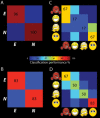Functional dissociation between anterior temporal lobe and inferior frontal gyrus in the processing of dynamic body expressions: Insights from behavioral variant frontotemporal dementia
- PMID: 27510944
- PMCID: PMC6867423
- DOI: 10.1002/hbm.23322
Functional dissociation between anterior temporal lobe and inferior frontal gyrus in the processing of dynamic body expressions: Insights from behavioral variant frontotemporal dementia
Abstract
Several brain regions are involved in the processing of emotional stimuli, however, the contribution of specific regions to emotion perception is still under debate. To investigate this issue, we combined behavioral testing, structural and resting state imaging in patients diagnosed with behavioral variant frontotemporal dementia (bvFTD) and age matched controls, with task-based functional imaging in young, healthy volunteers. As expected, bvFTD patients were impaired in emotion detection as well as emotion categorization tasks, testing dynamic emotional body expressions as stimuli. Interestingly, their performance in the two tasks correlated with gray matter volume in two distinct brain regions, the left anterior temporal lobe for emotion detection and the left inferior frontal gyrus (IFG) for emotion categorization. Confirming this observation, multivoxel pattern analysis in healthy volunteers demonstrated that both ROIs contained information for emotion detection, but that emotion categorization was only possible from the pattern in the IFG. Furthermore, functional connectivity analysis showed reduced connectivity between the two regions in bvFTD patients. Our results illustrate that the mentalizing network and the action observation network perform distinct tasks during emotion processing. In bvFTD, communication between the networks is reduced, indicating one possible cause underlying the behavioral symptoms. Hum Brain Mapp 37:4472-4486, 2016. © 2016 Wiley Periodicals, Inc.
Keywords: connectivity; emotion; frontotemporal dementia; functional imaging; mentalizing.
© 2016 Wiley Periodicals, Inc.
Figures






References
-
- Abdollahi RO, Jastorff J, Orban GA (2013): Common and segregated processing of observed actions in human SPL. Cereb Cortex 23:2734–2753. - PubMed
-
- Amlerova J, Cavanna AE, Bradac O, Javurkova A, Raudenska J, Marusic P (2014): Emotion recognition and social cognition in temporal lobe epilepsy and the effect of epilepsy surgery. Epilepsy Behav 36:86–89. - PubMed
-
- Anwander A, Tittgemeyer M, von Cramon DY, Friederici AD, Knosche TR (2007): Connectivity‐Based Parcellation of Broca's Area. Cereb Cortex 17:816–825. - PubMed
Publication types
MeSH terms
LinkOut - more resources
Full Text Sources
Other Literature Sources
Research Materials

